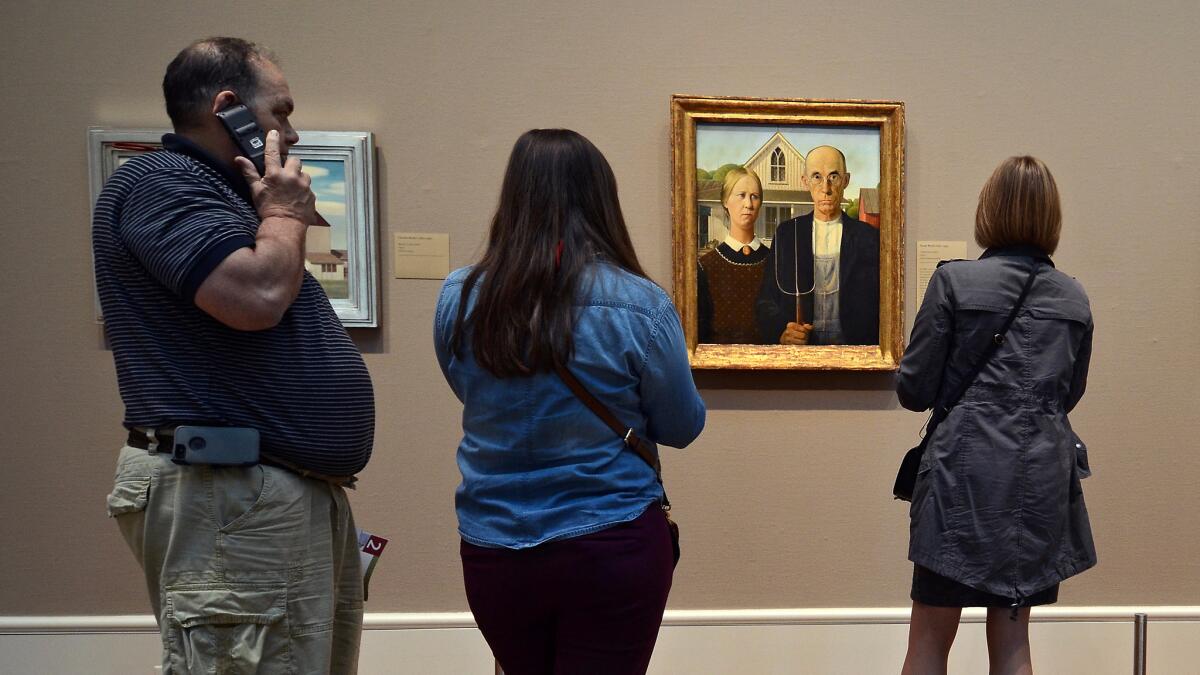In Iowa, piecing together the puzzle that is ‘American Gothic’ artist Grant Wood
Reporting from ANAMOSA, Iowa — If you’ve suspected there’s more to artist Grant Wood than the constantly parodied 1930 classic “American Gothic,” explore his homeland and you’ll find out why you’re right.
Wood was born 125 years ago in rural eastern Iowa near Anamosa, where summer is receding and fall is beginning its stutter step toward winter.
His native Jones County, about 200 miles west of Chicago, was still locked in ice when I visited in March, but tourism director Bob Hatcher and economic development chief Dusty Embree weren’t about to let freezing weather keep them from showing me around.
Iowans will teach you plenty about Wood, both from what they know and how they act. They are like the people he painted — strong, stubborn but generally sweet. “Iowa nice,” it’s called.
Cecilia Hatcher, Bob’s sister-in-law, was the volunteer on duty at our first stop, the Grant Wood Art Gallery in downtown Anamosa.
“We don’t want people to think of him only for ‘American Gothic,’” she said, gesturing toward prints, “Gothic” parodies, a Wood-designed chair and memorabilia.
I could have spent hours in the research library, but Embree pulled me past a purple-painted “Gothic” couple statue and out the door. We had lots of ground to cover.
Four miles east along the Grant Wood Scenic Byway, Hatcher pointed out the unmarked farm where Wood was born in 1891. I recognized the one-room Antioch School he attended from 1897 to 1901 from his painting “Arbor Day,” which depicts a spring tree planting by students and their teacher, and from the trees and hills in “Young Corn.”
At Riverside Cemetery, the two explained the family tensions and why Wood, his mother, Hattie, and sister, Nan, rest in the Weaver section, not in the nearby Wood plot, where his father, Francis, is buried.
Hattie moved with her four young children to live with her parents in Cedar Rapids after Francis’ death in 1901. Francis Wood was a stern Quaker who discouraged young Grant’s early art, and the families never got on after the elder Wood’s death.
We followed the highway bends Wood depicted in “Death on the Ridge Road,” which shows the imminent collision of a truck and cars on the narrow fence- and powerline-hemmed road, on the way to Stone City, about four miles west of Anamosa.
There, Hatcher pointed out the spot where Wood stood to paint the hamlet that hosted his famed but short-lived Stone City Colony and Art School.
The colony was Wood’s attempt to create an artistic home for fellow regionalists. Art students and nationally prominent teachers, including Wood, Thomas Hart Benton and John Steuart Curry, stayed in abandoned limestone buildings and camped in obsolete horse-drawn ice wagons loaned by Hubbard Ice Co. of Cedar Rapids.
Participants painted by day, partied by night and sold their work to crowds of visitors on weekends. The project was a financial bust but attracted national attention in the summers of 1932 and ’33.
Replicas of the ice wagons, which were fancifully decorated by their occupants, are rolled out each September to re-create the colony atmosphere for the colony atmosphere for the Stone City Festival, an annual celebration of student art. It was Sept. 18 this year.

The ice wagons are stored in a metal building in Stone City and are decked out to look like the “American Gothic” house. That fools tourists into stopping for pictures and amuses the locals, but the real house is in Eldon, about 145 miles southwest of Anamosa, where I visited a few days later with Holly Berg, director of the artifact-packed American Gothic House Center next door.
She jumps easily from answering questions on Wood’s European influences to lending you a pitchfork for a “Gothic” parody photo.
I spent another day touring Cedar Rapids, about 25 miles southwest of Anamosa, and Iowa City, about 30 miles south of there. I found the modestly marked home, across the street from Coe College near downtown, where Wood lived with his mother and siblings through his high school years.
I visited his studio and the excellent Wood exhibit at the Cedar Rapids Museum of Art.
You could spend weeks retracing Wood’s tracks in these communities where he spent his life. After a late failed marriage, he died of pancreatic cancer, just shy of his 51st birthday.
The multitalented Wood left an indelible imprint on his home community. I couldn’t help but wonder whether he might have been known nationally for more than his image of the pitchfork-wielding farmer and shifty-eyed daughter if he had lived longer.
Taking the tour
Start your tour where Grant Wood started — in rural Jones County, Iowa. Trace his career through Cedar Rapids and Iowa City, and finish with a scenic drive to Eldon. Who can resist a photo at the American Gothic House?
Jones County
Grant Wood Art Gallery, Anamosa, is your free headquarters for hometown memorabilia, photos, videos, parodies, prints, books and directions to other Wood sites.
Info: 124 E. Main St., Anamosa; (319) 462-4267, www.grantwoodartgallery.org. Open 1-4 p.m. daily.
Riverside Cemetery, Anamosa, contains the graves of Wood, sister Nan and mother Hattie.
Antioch School, Anamosa
You can follow the Grant Wood Scenic Byway (Iowa Highway 64) four miles east of the cemetery past Wood’s unmarked birthplace to the restored one-room Antioch School, the subject of his work “Arbor Day.” The building is open 1-4 pm. Sundays through Oct. 15 and for special events; (319) 377-0455.
Stone City Art Colony, Stone City
You can take County Road E28 four miles west from Anamosa to the setting of Wood’s painting “Stone City.” The Wood connection, winding roads and hilly scenery make the historic village attractive to motorcyclists and others who want to check out the site of Wood’s famed but short-lived Stone City Art Colony of the early 1930s. You can view an “American Gothic” house look-alike and dine at the General Store Pub overlooking the Wapsipinicon River. An active limestone quarry is in operation. A blacksmith shop is being restored, and the old school serves as the community building. Other structures are privately owned.
Info: Stone City Foundation
Cedar Rapids
At the Cedar Rapids Museum of Art, you can see see “Woman With Plants,” “John B. Turner,” “Pioneer” and other paintings plus his creations in sculpture, jewelry, metalwork and more in what the museum’s website calls the world’s largest collection of Wood’s work.
Info: 410 Third Ave. S.E., Cedar Rapids; (319) 366-7503, www.crma.org. Open noon to 4 p.m. Tuesdays, Wednesdays, Fridays and Sundays, noon to 8 p.m. Thursdays and 10 a.m. to 4 p.m. Saturdays. Adults $7, seniors (62 and older), college students with ID $6, and children 6-18 $3. Children younger than 6 are admitted free.
Also downtown: Wood’s studio and home, 5 Turner Alley. See the loft Wood ingeniously remodeled as a residence and the studio where he created “American Gothic” and other famed works and hosted theatrical events.
Downstairs, in a former stable, you can enjoy educational programs and artistic activities at the Armstrong Visitor Center.
Info: 5 Turner Alley, www.lat.ms/woodstudio. Admission is free.
The Veterans Memorial Building boasts Wood’s stained-glass masterpiece, which can be viewed for free.
Info: 50 Second Ave. Bridge, www.lat.ms/vetmemorial.
Iowa City
Drive by the 1885 Italianate home at 1142 E. Court St. that Wood renovated during his marriage to Sarah Maxon. The Woods showcased Midwestern art and entertained notables in the now privately owned home.
The Grant Wood Art Colony next door provides housing for visiting University of Iowa art fellows.
On campus, you can take a walk on the winding paths along the Iowa River and see the Wood-designed Danforth Chapel and the Old Art Building, where he taught. The Art Building, severely damaged during the 2008 floods, has a Wood-designed mural in the basement but is closed to the public while the university figures out how to use it.
Eldon
Pose for photos at the American Gothic House Center, 93 miles southwest of Iowa City. Borrow photo props such as pitchforks and print smocks inside and view free exhibits showcasing Wood’s life and the house’s history.
Info: American Gothic House Center, 300 American Gothic St., Eldon; (641) 652-3352, www.americangothichouse.net. Winter and summer hours vary.
Events
Experience the people and flavor of Iowa at Grant Wood birthday events. Here’s a sampler. Call or email to confirm dates, details.
Overalls All Over: A Grant Wood Experience: Downtown Cedar Rapids, through September. American Gothic couple statues designed by local artists.
Info: (319) 398-5009, www.croveralls.com
Grant Wood Art Colony Biennial Symposium: “Myth, Memories, and the Midwest,” Art Building West, University of Iowa, Iowa City, Oct. 28 and 29. Scholars, experts explore issues tied to Wood’s life, legacy. Free.
Info: (319) 384-3579, www.art.uiowa.edu
In Jones County, through December, “Windows of Wood,” 18 Gothic windows decorated by local are displayed at various locations.
Grant Wood-themed Pumpkinfest Oct. 1, Anamosa, anamosachamber.org/pumpkinfest.
Anamosa Parks & Recreation Department Tree Walk, 5-8 p.m. Dec. 9, noon-8 p.m. Dec. 10, noon-4 p.m. Dec. 11. View 80 decorated Christmas trees from businesses and community groups; prize for the best Grant Wood-themed tree. Admission is free. Lawrence Community Center, 600 E. Main St.; (319) 462-6181. Watch www.anamosa-iowa.org for details.
More to Read
Sign up for The Wild
We’ll help you find the best places to hike, bike and run, as well as the perfect silent spots for meditation and yoga.
You may occasionally receive promotional content from the Los Angeles Times.






